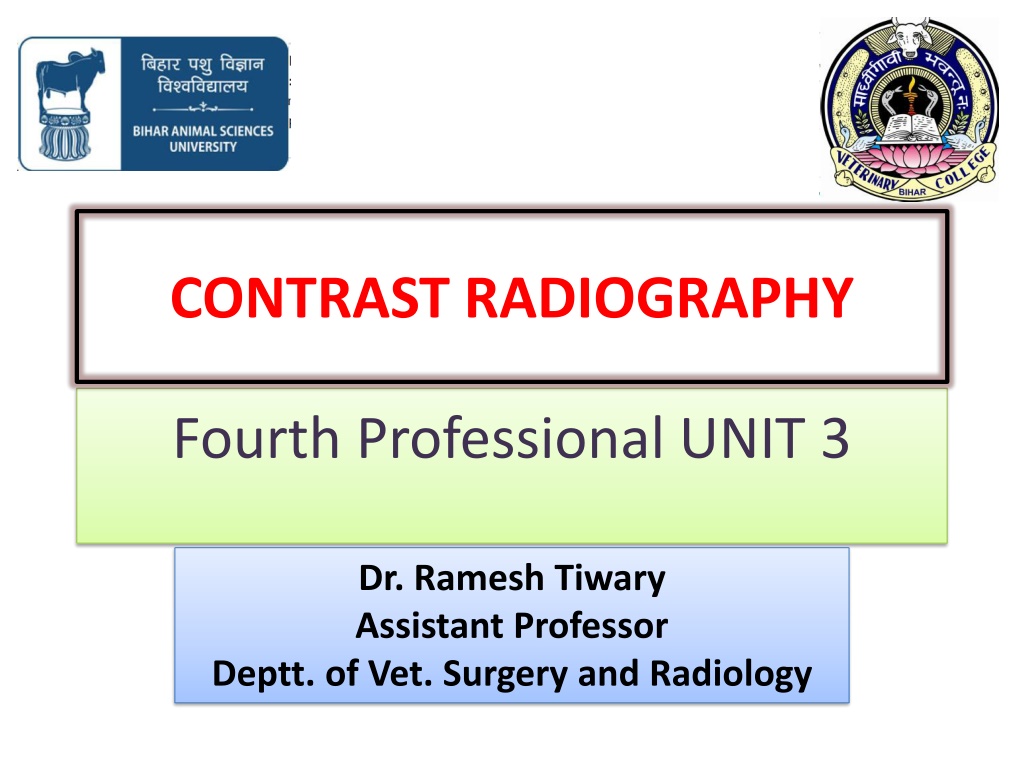Understanding Contrast Radiography in Veterinary Surgery and Radiology
Contrast radiography is a crucial technique in veterinary medicine that involves using contrast media to enhance visualization of organs and lesions. Different types of contrast media, positive and negative, are used to alter tissue radio density for better demarcation. Barium and iodine compounds are common positive contrast media, while air and carbon dioxide are examples of negative contrast media. Water-soluble iodine compounds are also commonly used in contrast radiography to enhance imaging quality.
Download Presentation

Please find below an Image/Link to download the presentation.
The content on the website is provided AS IS for your information and personal use only. It may not be sold, licensed, or shared on other websites without obtaining consent from the author. Download presentation by click this link. If you encounter any issues during the download, it is possible that the publisher has removed the file from their server.
E N D
Presentation Transcript
CONTRAST RADIOGRAPHY Fourth Professional UNIT 3 Dr. Ramesh Tiwary Assistant Professor Deptt. of Vet. Surgery and Radiology
Contrast media Substances that attenuates the beam to a different degree than the surrounding tissue Used to enhance areas of the body that have the same attenuation of surrounding tissue Contrast media increases contrast on film
Basic Radiographic Opacities Radiographic image: It is produced when x- ray goes through the body part: penetration and absorption, hence== What you got?? Basic radiographic opacities Air Fat Water Bone Metal/+Contrast BLACK GREY GREY GREY WHITE
Contrast Radiography Tissue radio density and its surrounding is deliberately altered, for better visualization and demarcation. Group of radiographic procedures performed by administration of a contrast medium What for?? Visualization of individual organs Enhance lesions in a particular organ Some physiologic information Always performed after a survey radiograph
Contrast Media Positive Contrast Media (absorb X rays = radiopaque) Barium (inert, not metabolized or absorbed) Liquid Paste Iodine: Tri iodinated derivatives of benzoic acid Ionic-Diatrizoate, Iothalamate (Anion) Sodium, Meglumine (Cation) Non ionic Iohexol, Iopamidole The elements used for positive contrast should have atomic number (Z) above 50. Example - 56Barium, 53Iodine
Negative Contrast Media (do not absorb X rays = radiolucent) Air Carbon dioxide Nitrous oxide
Barium Sulphate preparation Insoluble Non absorbable by GIT Not used with ruptured GIT as it will lead to inflammation, formation of granulomatus mass and fibroma.
Water Soluble Iodine Compound Commonly used contrast medium having low osmolarity. 1. Sodium salt of Iothalamic 2. Meglumine salt of Iothalamic 3. Sodium salt of Ditriazoic 4. Meglumine salt of Ditriazoic
CHOLECYSTAPAQUES Very useful in liver functions Excreted exclusively through biliary-system Hence used for outlining biliary system and gall bladder Mostly used as IV Water soluble organic iodine. Intravenous preparations Meglumine iodoxamate, ioglycamate, Oral preparation :- Sodium iopodate, iopanoic acid iotroxate.
Viscous and Oily preparation Used for Myelography if Non-iodine low osmolarity medium not available.
EXAMPLES OF CONTRAST RADIOGRAPHY 1. 2. 3. 4. 5. 6. 7. 8. 9. 10. Osteomedullography 11. Angiography 12. Urethrography 13. Cystography Dacrocystorhinography Sialography Bronchography Reticulography Pneumocystography Intravenous Pyelography Myelography Arthrography Fasciography : : : : : : : : : : : : : Nasolacrymal duct Salivary gland Bronchioles Reticulum Abdominal Cavity Urinary tract Spinal Cord Joints Tendon and associated structures Channels of long bones. Arteries Urethra Urinary Bladder
Principles C A B extrinsic mass mucosal mass submucosal or intramural mass
Mucosal Mass B A























